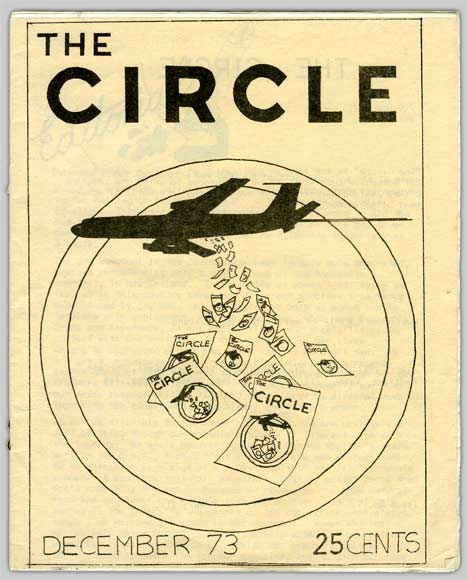This essay written by Linda Evans was first published in Women Together: a History of Women's Organisations in New Zealand in 1993.
In winter 1973, six Christchurch lesbians met to talk about their lives and work out what the new ideas of women's liberation and gay liberation meant to them. Others soon joined them in large weekly meetings. For some, informal meetings and relaxed socialising were sufficient; others felt 'a growing awareness of and anger at the constant prejudice we face'. [1] Together they formed SHE, settling on 'Sisters for Homophile Equality' to fit the letters. [2]
The manifesto reflected the group's efforts to include both women's liberation and gay politics. By 1993, its list of demands for an end to discrimination in employment, housing and other areas was still relevant. The proposed programme of action emphasised improving the low self-image of lesbians. Activities in the first two months included 'letters to the editor, increasing contact with other liberation organisations, research into many aspects of being gay', and 'small but morale-boosting' protest activities. [3]
Meanwhile a group of Wellington lesbians who had formed a caucus in Gay Liberation were increasingly frustrated by the lack of focus on lesbian concerns and the sexism of the gay men. A few were also active in women's liberation. In 1973 they met members of SHE, and later corresponded with them, 'to discuss political ideas and to develop a lesbian critique of our lives and the world we lived in'. [4]

The cover of the first issue of Circle, published by Sisters for Homophile Equality (SHE) in Wellington between 1973 and 1985.
In late 1973, Wellington began a SHE group and a magazine, Circle, which enabled lesbians all over the country to communicate and build up a network of contacts. It covered the activities of lesbian groups, reflecting their developing politics, and reprinted articles from the overseas publications it exchanged with, providing stimulating ideas and linking lesbians here to the international movement. It was always printed by lesbians, including, for five years, Herstory Press.
Both SHE groups aimed to reach as many lesbians as possible. Members were mainly young and Pākehā (though many Māori were part of the social networks), but they had diverse class backgrounds which were a source of both strength and tension. In February 1974, four members started Club 41 in Vivian Street, to provide a Wellington venue similar to Auckland's KG Club. The emerging lesbian culture was most likely to meet the older ones, both Māori and Pākehā, at the club, which operated until 1977.
Though newspapers refused to print the word 'lesbian', advertisements in the personal columns put lesbians in touch with support, contacts and information. Wellington SHE members also replied to the many who wrote to Circle seeking resources and help. SHE members appeared on or wrote for the mainstream media and spoke to groups and schools as open and proud lesbians, explaining lesbian perspectives. They supported each other in coming out and dealing with repercussions. In 1974, Wellington SHE prepared Straight Answers to Queer Questions, a pamphlet suggesting how lesbians could answer common questions asked at home, at work or at public events.
In March 1974, SHE Wellington organised the first national lesbian conference, which resulted in a Palmerston North SHE group forming. That year the first attempt at homosexual law reform, the Crimes Amendment Bill, was introduced; SHE made detailed critical submissions and energetically joined the widespread opposition to the Wall Amendment, which sought to outlaw any positive presentation of homosexuality to those aged under twenty.
However, it was becoming increasingly difficult to hold SHE's diverse participants together. Some wanted only to socialise, others to continue political explorations. Gradually the Christchurch meetings ceased and the unique, enthusiastic, cross-class membership dispersed. Christchurch SHE activists took a leading role in feminist projects there, especially in refuge, the women's centre, and later as writers and artists, and also worked in lesbian separatist groups. In Wellington, active membership diminished as other alternatives increased, though the core group worked hard, for example on organising an educational workshop and lesbian-only sessions at the 1975 United Women's Convention. Large numbers also turned out for any demonstration or event such as the convention.
In 1977, SHE made submissions on the Human Rights Commission Bill, arguing for 'sexual orientation' to be among the outlawed grounds for discrimination; however, that year SHE meetings ceased, though longstanding members continued to operate a box number and telephone contact until 1983. An expanded Circle collective published the magazine until 1985.
Linda Evans
Notes
[1] 'A Homosexual Women's Equality Organisation', ms [n.d.], SHE miscellaneous papers, LAGANZ, ATL.
[2] 'Homophile', used by earlier gay organisations in Europe, was preferred to 'homosexual'.
[3] SHE newsletter, October 1973, SHE miscellaneous papers, LAGANZ, ATL
[4] Marilynn Johnson, 17 September 1973, Circle, No. 7, June 1974, p.7.
Unpublished sources
Morrigan Severs, Valda Edyvane, Alison Laurie, interviewed by Linda Evans, Wellington, 1992
SHE collection, in possession of Valda Edyvane, Wellington
SHE miscellaneous papers, Lesbian and Gay Archive of New Zealand (LAGANZ), ATL
Published sources
Circle, 1973–1974; Lesbian Feminist Circle, 1974–1985
Johnson, Marilynn, 'Lesbian and Feminist: Invisible Among the Invisible', in Christine Dann and Maud Cahill (eds), Changing Our Lives, Bridget Williams Books, Wellington, 1911, pp. 65–69


Community contributions